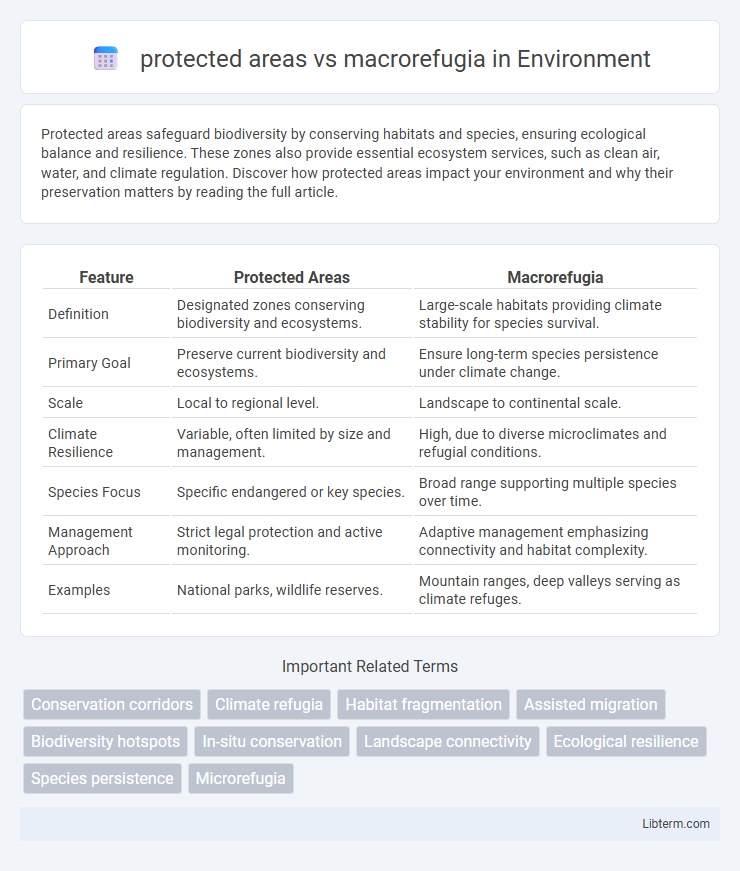Protected areas safeguard biodiversity by conserving habitats and species, ensuring ecological balance and resilience. These zones also provide essential ecosystem services, such as clean air, water, and climate regulation. Discover how protected areas impact your environment and why their preservation matters by reading the full article.
Table of Comparison
| Feature | Protected Areas | Macrorefugia |
|---|---|---|
| Definition | Designated zones conserving biodiversity and ecosystems. | Large-scale habitats providing climate stability for species survival. |
| Primary Goal | Preserve current biodiversity and ecosystems. | Ensure long-term species persistence under climate change. |
| Scale | Local to regional level. | Landscape to continental scale. |
| Climate Resilience | Variable, often limited by size and management. | High, due to diverse microclimates and refugial conditions. |
| Species Focus | Specific endangered or key species. | Broad range supporting multiple species over time. |
| Management Approach | Strict legal protection and active monitoring. | Adaptive management emphasizing connectivity and habitat complexity. |
| Examples | National parks, wildlife reserves. | Mountain ranges, deep valleys serving as climate refuges. |
Introduction to Protected Areas and Macrorefugia
Protected areas are designated regions established to conserve biodiversity and ecosystems, often featuring legal protections to limit human activities and preserve habitat integrity. Macrorefugia refer to large-scale geographic regions that act as long-term safe havens for species during environmental changes, maintaining stable climate conditions and supporting biodiversity persistence. While protected areas focus on current conservation management, macrorefugia emphasize climate resilience and natural refuges essential for species survival amid global change.
Defining Protected Areas: Purpose and Scope
Protected areas are designated regions aimed at conserving biodiversity, ecosystems, and cultural heritage, often encompassing national parks, wildlife reserves, and marine sanctuaries. Their scope involves legal protection and management strategies to prevent habitat destruction, control human activities, and maintain ecological integrity. In contrast, macrorefugia are large-scale climatic refuges providing stable environmental conditions that support species survival during periods of climatic change, serving as critical buffers within or beyond protected areas.
What Are Macrorefugia? Concepts and Characteristics
Macrorefugia are large, stable geographic areas that provide long-term habitat protection for biodiversity during climate fluctuations, preserving species by maintaining favorable microclimates. Unlike smaller protected areas, macrorefugia encompass diverse ecosystems and support broader ecological processes, acting as critical buffers against environmental change. Their key characteristics include extensive size, ecological connectivity, and resilience to climate extremes, making them essential for strategic conservation planning.
Ecological Roles: Protected Areas vs. Macrorefugia
Protected areas serve as critical habitats that safeguard biodiversity by maintaining ecological processes and species populations within defined boundaries. Macrorefugia function as large-scale climate refuges, facilitating species survival and migration during environmental changes by providing stable microclimates and resources. Both protected areas and macrorefugia play complementary ecological roles in conserving biodiversity, with protected areas focusing on immediate habitat protection and macrorefugia ensuring long-term species persistence under climate change.
Climate Change Resilience: Comparative Advantages
Protected areas serve as critical sanctuaries preserving biodiversity and ecosystem functions amidst climate shifts, offering regulated habitats that reduce human disturbances and facilitate species adaptation. Macrorefugia, large-scale stable environments with climate buffering properties, provide broader, long-term resilience by sustaining ecological communities during extreme climate fluctuations and enabling species migrations. The integration of protected areas within macrorefugia networks enhances climate change resilience by combining localized protection with landscape-level stability, optimizing conservation outcomes under evolving environmental conditions.
Biodiversity Conservation Strategies
Protected areas serve as critical zones for preserving biodiversity by limiting human activities and maintaining natural habitats, whereas macrorefugia are large-scale regions that provide stable environmental conditions allowing species to survive long-term climate fluctuations. Biodiversity conservation strategies increasingly integrate protected areas with macrorefugia to enhance ecosystem resilience and facilitate species adaptation under global climate change. Incorporating macrorefugia into conservation planning supports genetic diversity preservation and connectivity between habitats, improving overall effectiveness in maintaining ecological integrity.
Connectivity and Landscape-Level Protection
Protected areas provide essential localized conservation but often lack sufficient connectivity to support species migration and genetic flow across large landscapes. Macrorefugia encompass extensive, interconnected habitats that enable landscape-level protection by maintaining ecological processes and enhancing resilience to climate change. Enhancing connectivity between protected areas through ecological corridors and buffer zones is critical for preserving biodiversity and ecosystem services within macrorefugia networks.
Management Approaches and Challenges
Protected areas management prioritizes biodiversity conservation through strict regulations, habitat restoration, and enforcement to prevent human disturbances, yet faces challenges from climate change-induced species shifts and limited adaptability. Macrorefugia management emphasizes preserving large-scale climate-stable habitats that support species persistence despite environmental fluctuations, requiring dynamic, landscape-level strategies that integrate climate projections and connectivity corridors. Both approaches demand adaptive management frameworks, stakeholder collaboration, and robust monitoring systems to overcome uncertainties in ecological responses and socio-political constraints.
Policy Implications and Future Directions
Protected areas serve as critical tools in biodiversity conservation, yet they often fall short in accommodating species' range shifts due to climate change, necessitating adaptive policy reforms. Incorporating macrorefugia--large, stable climatic zones that support species persistence--into conservation strategies can enhance ecological resilience and biodiversity protection under future climate scenarios. Policy frameworks must prioritize dynamic management approaches that integrate macrorefugia identification, connectivity enhancement, and stakeholder collaboration to ensure long-term conservation effectiveness.
Integrating Protected Areas and Macrorefugia for Conservation
Integrating protected areas with macrorefugia enhances biodiversity conservation by preserving critical habitats that offer climate resilience and long-term species survival. Protected areas serve as established conservation zones, while macrorefugia provide stable microclimates essential for species adapting to environmental changes. Combining these strategies supports ecological connectivity, promotes genetic diversity, and strengthens ecosystem services crucial for maintaining global biodiversity under climate change pressures.
protected areas Infographic

 libterm.com
libterm.com